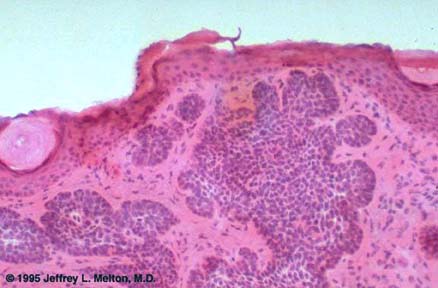Keratinocyte - human cell - function

Keratinocyte - The cell type that makes up most of the epidermis, also called a squamous cell. Keratinocytes originate in the first of the four layers of the epidermis, the stratum basale. Here they either replicate to generate new keratinocytes or migrate upward. Migratory keratinocytes acquire melanin from melanocytes. The keratinocytes carry this pigment to the outer layers of the SKIN, where it appears as the skin’s normal color or causes the skin to darken (as in a tan). At each of the epidermis’s layers the keratinocytes become more compressed. Their internal structures break down, and the keratin they contain causes them to harden.
At the stratum corneum, the outer layer of the epidermis, the keratinocytes overlap tightly, looking somewhat like irregular shingles when viewed under the microscope. At the culmination of this journey, which takes about four weeks, the keratinocytes die and slough from the skin’s surface. The fingernails and toenails are much more tightly compressed and hardened keratinocytes. They do not shed as does the stratum corneum but instead grow forward over the front of the fingers and toes at the rate of about one eighth inch every four to five weeks.
Hyperkeratosis is a state in which the keratinocytes migrate through the epidermis far more rapidly than normal, sometimes cutting the journey to 10 days. This accelerated journey causes more keratinocytes than the body can shed to accumulate in the HAIR follicles and sebaceous structures, causing numerous hyperkeratosisrelated conditions from ACNE and atopic DERMATITIS to PSORIASIS and SEBORRHEIC KERATOSIS. Squamous cell carcinoma, a common type of SKIN CANCER, arises from keratinocytes.
For further discussion of keratinocytes within the context of integumentary structure and function please see the overview section “The Integumentary System.”
See also ICHTYOSIS; MELANOCYTE; NAILS.